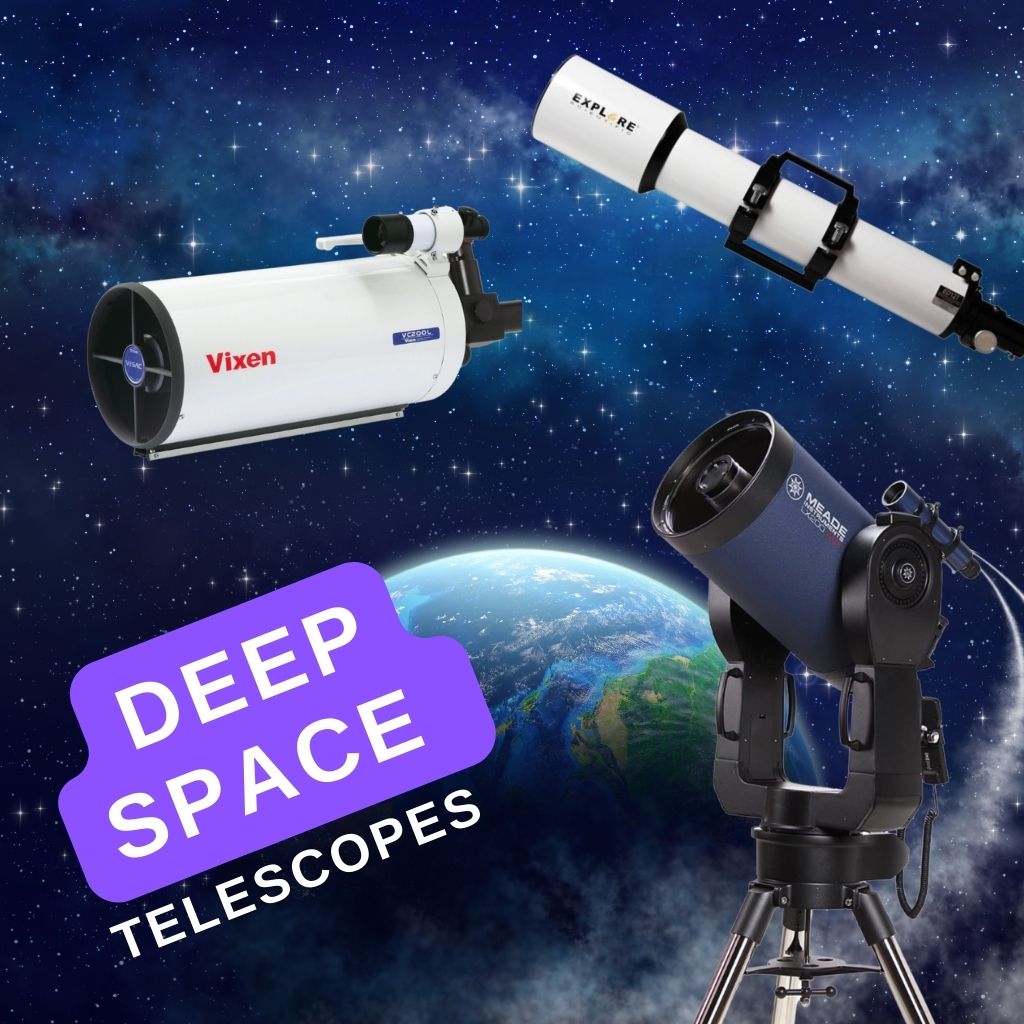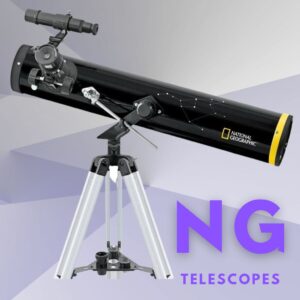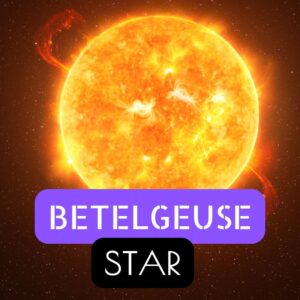This site contains affiliate links to products. I may receive a commission for purchases made through these links.
When choosing the best telescopes for deep-space viewing, we consider several important features. These features have helped us pick the top nine telescopes for you. Here’s what we look for to ensure you get a great stargazing experience:
- Large aperture: Essential for deep-space viewing, a large aperture gathers more light, making celestial objects clearer and more visible. Ideal for beginners and advanced users alike, larger apertures like 6-inch or 12-inch offer a balance between price, performance, and portability, enhancing your ability to see faint and distant objects.
- High-quality optics: Crucial for viewing deep-space objects, high-quality optics, including a well-crafted primary mirror and high-precision lenses, ensure clear and sharp images. Advanced telescopes even adjust mirrors in real-time to correct distortions, providing the clearest view of celestial bodies.
- Sensitive detectors: The best deep-space telescopes feature highly sensitive detectors that capture faint light from distant celestial objects. This sensitivity is key to discovering and observing objects that are far away or obscured by cosmic phenomena.
- Advanced cooling systems: Sophisticated cooling systems are necessary to reduce thermal noise and prevent overheating, ensuring clear image quality over extended viewing periods. This also extends the lifespan of the telescope by protecting its optical elements from heat damage.
- Multi-wavelength operation: The ability to observe in various wavelengths, from visible light to infrared and ultraviolet, allows for comprehensive study of different celestial objects and phenomena, providing insights into the universe’s most energetic and distant events.
- Stable platform and pointing accuracy: A stable platform, often provided by an equatorial mount, and accurate pointing are vital for capturing sharp, clear images. Computerized tracking systems enhance this stability, allowing for precise, blur-free observations of moving celestial objects.
- Durability and resilience: Telescopes designed for deep-space observation must withstand diverse environments, ensuring they remain operational in various climates and conditions. This resilience extends their usability and protects your investment.
- Autonomous operation: For long-term studies, telescopes that can track objects autonomously and perform remote operations are invaluable. This saves time and effort and allows for continuous observation without manual adjustment.
- High data storage and transmission: Adequate data storage and fast transmission capabilities are essential for handling and analyzing the high-resolution images typical of deep-sky astronomy, enabling efficient review and sharing of findings.
1. Celestron CPC Deluxe 1100 HD: Best telescope overall
This Celestron CPC Deluxe 1100 HD telescope is one of their flagships. And it’s built with astrophotography in mind. That means you get the best optics for imaging.
This is one of Celestron’s best-sellers. It is very popular among amateur astronomers. And it’s also got star power because it was Stephen Hawking’s preferred telescope.
It comes with an 11-inch objective lens, which allows it to collect as much light as needed to view distant objects. These include star clusters, galaxies, nebulae, and more.
The images are crisp, and you get the SkyAlign setup. SkyAlign uses GPS to view over 40,000 objects already stored in the database automatically.
It comes with a sturdy mount and motors that fine-tune precision tracking of the objects across the sky. And the cherry on top is its ability for periodic error correction.
Specifications
- Aperture: 279.4mm (11″)
- Focal Length: 2800mm (110″)
- Focal Ratio: f/10
- Focal Length of Eyepiece: 23mm (0.91″)
- Magnification of Eyepiece: 122x
- Highest Useful Magnification: 660x
- Weight: 65 lbs (29.5 kg)
2. Meade LX200-ACF: Best performing compact telescope
The Meade LX200 is great if you want a powerful telescope in a compact size. It comes in several different aperture sizes, but we recommend the 12-inch version.
The Meade 12″ LX200 ACF telescope is perfect for amateur astronomers. It’s great for both viewing and imaging a celestial object without vibrations. The incredible stability comes from its solid fork arm.
It has push-button controls. And it can automatically locate and track objects, thanks to its motorized mount. You also get the AutoStar II controller, which contains a rich database about celestial objects.
It has a mirror lock, which mechanically locks your mirrors in place. As a result, you don’t get residual image shifts in your photographs.
This helps to eliminate distortions from the pictures, making this telescope wonderful for astrophotography.
Its only drawback is that it’s very heavy. However, if that’s not a problem, it is a good telescope.
Specifications
- Aperture: 305mm (12″)
- Focal Length: 3048mm (120″)
- Focal Ratio: f/10
- Focal Length of Eyepiece: 50mm (1.97″)
- Magnification of Eyepiece: 117x
- Highest Useful Magnification: 608x
- Weight: 133 lbs (60 kg)
3. Orion SkyQuest XX16g GoTo Truss Tube Dobsonian: Best telescope for observing faint and distant celestial objects
This behemoth of a telescope is no joke. Orion SkyQuest XX16 comes with a 16-inch objective lens, which makes it one of the biggest on our list. It’s perfect for advanced users because it has a tonne of features.
It’s a Dobsonian reflector telescope that combines a motorized base and big aperture optics.
Despite its massive size, Orion designed it with portability in mind. Therefore, you can take the entire telescope apart without using any tools. This converts it into easily transportable components in your car to be taken to your viewing site.
And once you are there, you can reassemble the telescope. Even the Dobsonian base can be easily taken apart without using tools.
Its GoTo mount can easily locate and track over 42,000 objects in its database. Plus, you can do it yourself if you don’t have the patience to wait as the motors move the telescope over a large angle.
That’s right! You can manually move this telescope across and point it at a general area where your object might be. After that, the GoTo system will locate it for you.
And it’s large aperture helps you see all the little details in the deep space objects. It’s one of the best Dobsonian telescopes.
Specifications
- Aperture: 406mm (16″)
- Focal Length: 1800mm (71″)
- Focal Ratio: f/4.4
- Focal Length of Eyepiece: 28mm (2″) and 12.5mm (1.25″)
- Magnification of Eyepiece: 144x and 64x
- Highest Useful Magnification: 800x
- Weight: 195 lbs (88 kg)
4. Sky-Watcher EvoStar 120 APO: Best telescope for all skill levels
The Sky-Watcher EvoStar is a great telescope for taking pictures. It has the best glass and mirror coatings for color correction. This prevents distortions of the image.
These coatings are called the MHTC. This stands for Metallic High-Transmission Coatings that produce sharp images with accurate colors.
And the best part is that it’s a telescope for everyone. As your skill in astronomy improves, you can use this telescope for more sophisticated observations.
Specifications
- Aperture: 120mm (4.7″)
- Focal Length: 900mm (35″)
- Focal Ratio: f/7.5
- Focal Length of Eyepiece: 25mm (2″) and 5mm (0.2″)
- Magnification of Eyepiece: 180x and 45x
- Highest Useful Magnification: 236x
5. Explore Scientific ED127 Essential Series: Best telescope for viewing the most detail
The Explore Scientific ED127 is perfect for astrophotographers because it was made to capture stunning visuals.
It uses the HOYA FCD1 ED glass. This produces the sharpest, clearest images among commercially available telescopes. It lets you see the details of different phenomena, like star clusters in the night sky.
Using this telescope, you can capture the sharpest images of celestial objects like the Pillars of Creation. The best part is that it’s one of the lightest telescopes on our list and is solar-powered.
Specifications
- Aperture: 127mm (5″)
- Focal Length: 952mm (37″)
- Focal Ratio: f/7.5
- Weight: 18 lbs (8.16 kg)
6. Takahashi FSQ-106EDX4: Best telescope for urban and remote observing
This telescope is great for people who are interested in amateur astrophotography in different observing locations both urban and remote. It’s meant to act as a telephoto lens for different digital cameras.
It is based on the Quadruplet Petzval optical formula. This also adds an ED glass to the telescope, making this telescope perfect for widefield imaging of the deep sky.
It comes with a built-in camera angle adjuster and a micro focuser. And it also has a retractable dew shield, which reduces the room this telescope takes up.
Specifications
- Aperture: 106mm (4.2″)
- Focal Length: 530mm (20.9″)
- Focal ratio: f/5
- Weight:15.4 lbs (7 kg).
7. Vixen Optics VC200L: Best telescope for viewing star clusters
This is one of the best telescopes for deep space observations of stars and widefield imaging.
Vixen’s Optics VC200L comes with a high-precision objective lens and a convex secondary lens. It also has a triplet of corrective lenses. All of these combine to produce very sharp images.
The telescope corrects spherical and coma aberrations. It also reduces the curvature of the field. This means the images have no distortions and look stunningly clear.
Specifications
- Aperture: 200mm (7.9″)
- Focal Length: 1800mm (71″)
- Focal Ratio: f/9.0
- Weight: 13 lbs (6 kg)
8. William Optics FLT 132 Triplet APO: Best telescope for capturing the sharpest images
The William Optics FLT 132mm Triplet Refractor is one of the best telescopes for astrophotography. That’s because it produces exceptionally sharp images.
It has incredible color correction and produces some of the clearest images on the list. This refractor telescope has a high-quality apochromatic objective. This makes it ideal for astrophotography.
But, it will break your bank. These telescopes’ price can be just as high as their image quality.
Specifications
- Aperture: 132mm (5″)
- Focal Length: 925mm (36″)
- Focal Ratio: f/7
- Weight: 19 lbs (9 kg)
9. Zhumell Z10 Dobsonian: Best telescope for visual observation and astrophotography
Zhumell Z10 is one of the best Dobsonian telescopes. It’s very durable and produces high-quality images.
It has a simple, streamlined body. Its design is sturdy and durable. Therefore, you can use it for many years.
It comes with a cooling fan for your objective lens. This allows you to use it for long viewing sessions. The only drawback to this telescope is the need for a motorized mount.
Specifications
- Aperture: 254mm (10″)
- Focal Length: 1250mm (49″)
- Focal Ratio: f/5
- Focal Length of Eyepiece: 30mm (1.2″) and9mm (0.35″)
- Magnification of Eyepiece: 139x and 42x
- Highest Useful Magnification: 500x
Takeaway: Acquire the best telescope for deep-space objects to enhance your viewing pleasure
The best telescope for deep-space objects would depend on your preferences. For most people, the budget becomes a limiting factor when choosing the perfect telescope.
Most of the telescopes on the list are expensive. And when you go for the less expensive ones, the features reduce very steeply.
These telescopes will enhance your viewing experience as you embark on a deep-sky exploration.
You may also like:










